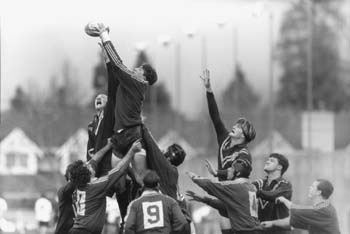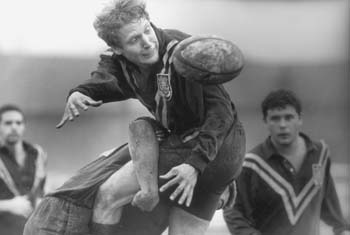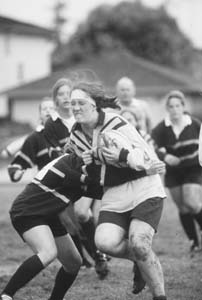The Red Brigades
Reach Party: UCSC's rugby team, the Rugby Slugs, disregard bodily welfare every fall and winter in a violently enjoyable display of aggression and fun.
The peaceful village discovers the allure of blood sports
By Ryan Coonerty
A MERICANS DEVOUR VIOLENCE like that second piece of pumpkin pie on Thanksgiving. We produce, consume and export bloodshed as if we were modern-day missionaries crusading for the Church of Rambo. Whether it is a shirtless man being wrestled to the ground during one of the dozen cop shows on TV nightly or Mike Tyson taking his infamous nibble on Evander Holyfield's ear, we are eager voyeurs enthusiastically watching our fellow men and women reverting to basic and primal violent interaction. Only America would invent the repeated slow-motion instant replays of one man seeking to control and beat another to a bloody pulp.
Whether we admit it or not, many of us, at some point in our lives, rubberneck, study and seek to emulate the doctrine of human relationships that former heavyweight champion Joe Frazier outlined: "I don't want to knock my opponent out. I want to hit him, step away and watch him hurt. I want his heart."
But can this American perpetual state of violence exist in the nuclear-free zone of Santa Cruz, a city known for peace groups singing one "Kumbaya" after another and graceful surfers skimming across waves? The answer is a fighting "yes." But, as always, there is a Santa Cruz-esque twist.
There is a small and growing violent subculture here in Surf City. The members of this particular subculture, however, are not gangbangers or criminals. They are the practitioners of blood sports: boxing, rugby and kickboxing. They are also the calm and friendly people from whom you would buy your home or even get to treat your child in a medical clinic. These people seek the regulated violence of the ring and the field.
Blood sports are attracting an increasing number of new recruits in our city, which is also the home of the Resource Center for Nonviolence and public monuments to saw-playing Wobblies and the victims of wars. These local men and women are finding release, enjoyment and even careers through the pummeling of their fellow human beings. Recreational violence is alive and well in Santa Cruz.
Give Blood
T HE EAST FIELD AT UCSC is arguably one of the most beautiful sports fields on earth. The small patch of green grass sits on a plateau among the green and golden rolling hills in perfect contrast to the dark blue of Monterey Bay. Students toss Frisbees and jog around the field as much for the view as for the exercise. The tranquillity of this setting is the reason many choose to come to town and the reason many will not leave when their education is done.
But on Saturday afternoons this winter, the serenity of this utopian place will be shattered with primal grunts as bodies collide and elbows hit home. The Slug rugby season has begun.
At first glance rugby is an incomprehensible chaos of runs, tackles and kicks with an occasional "scrum" in which half the players on the field lock shoulders, arms, legs and anything else they can bite, hold or latch themselves onto to create a de facto human battering ram. However, with a few minutes of explanation, the game becomes remarkably easy to follow. It has the easy constant flow of soccer with the violent physical contact of football, which makes it a natural candidate for American entertainment.
Like many European-based sports, rugby has few rules. The point of the game is to advance the ball down the field with lateralpasses, kicks and long runs while preventing--by any means necessary--your opponent from doing the same. Fifteen playerson each side are divided almost evenly between big guys or women and, in the context of rugby, smaller participants.
The larger, and generally slower, players are the "forwards," rugby's equivalent to football's offensive linemen. Their task is to win scrums and clear the opponents away from the ball while the smaller "backs" slash and pass in open field. It is a game that requires an amazing amount of cooperation and a willingness to sacrifice and submit one's ego and body to the good of the team.
What differentiates rugby from its successor, football, is that there is no padding. Shoulders rap against ribs and heads bang thighs over and again, with nothing to cushion the impact. The vocabulary of the players reflects this violent reality. There are a half dozen phrases that describe a hit--like "light 'em up" and "ring their bell"--that leaves an opponent lying on the ground gasping for air or sometimes consciousness.
This year's Rugby Slugs are reflective of the usual unusual population of rugby players. More than half are the best and brightest the university has to offer, students boasting majors such as biochemistry and theoretical physics, scholars with graduate school in their futures. Some of these players learned the game while studying overseas in countries such as England where ruggers (rugby players) are often the elite of Oxford and Cambridge, leaders soon to assume careers in banking and law.
Similarly, American rugby players are overwhelmingly affluent and well-educated. According to USA Rugby, the governing body for the sport, of the 40,000 active players in the country, 83 percent are college graduates and nearly half have done postgraduate work. Once in the workforce, two-thirds will have an annual income of $50,000 or more.
Slug team captain Lev Elson, 22, is representative of this demographic groups of ruggers. He has the stocky build of a big-city fire hydrant and is described by his fellow players as the quintessential workhorse. Elson admits that he is "obsessed with the game." On the field he is usually somewhere near the bottom of every pile, engaging in the game-within-the-game where fingers are stepped on and eyes are gouged in the quest to free the ball.
On this particular Saturday, Elson is forced to leave the game early because of a bloody and possibly dislocated nose. He paces the sidelines impatiently, shoving pieces of Kleenex into his nostrils so that the bleeding will stop and he can return to the game. Even though next year he will begin studying for his master's degree in structural biology at Stanford, his primary concern is an overseas rugby trip this spring.
Bait and Tackle: Local nonviolence supporters may see blood sports like rugby as a mainstreaming of violence, but Santa Cruz area players who take the hits know the mud and blood are just good clean fun and the perfect beginning to serious partying.
Crazy Love
L EV ELSON'S counterpart on the women's rugby team is Carol Soppe, a 21-year-old San Diego native with a self-described "Chia Pet" styled buzz haircut. Soppe, who had to sit out this game because she had suffered her third rugby-induced shoulder dislocation, is the heart and soul of the women's team. A third-year molecular biology student, she spends her limited free time comparing nasty purple bruises with the other players and trying to strengthen the team.
Soppe has personally recruited most of the female ruggers, discovering Israeli student Reut Dover in an "Introduction to Feminism" class. Dover quietly had an excellent game that day, scoring once and chasing an opponent down from behind, slamming her down hard just before the goal line.
Most of the women ruggers comment that they had "no idea what I was getting into." Most female ruggers, like Dover, had never played a contact sport before and found themselves expected to tackle an opponent in their first practice. But the trepidation quickly fades, and the new players, in the heat of competition or revenge for an earlier play, are grabbing members of the other team and driving them to the ground with abandon.
Yet for every molecular biology student or feminist on the field, there are players best described as "crazed." It is the paradox of violent sports. Some players excel because they apply the tough discipline they utilize in the classroom or their profession to the sport by methodically practicing and studying the game. Others, who lack this learned discipline, excel by utterly disregarding their bodily welfare. They are easily identifiable on the field this Saturday--one is vomiting between periods from a vicious hangover, while another enjoys a quick cigarette before jogging out onto the field.
It is one of the hallmarks of a rugby team that people with vastly different lives, ambitions, personalities and even approaches to the same game quickly develop an unparalleled camaraderie. Regardless of age, level or gender of a team, there is always a "rugby house," which seem to possess endless quantities of beer, a fired-up barbecue and a mammoth, sometimes half-drunk, dog.
These houses host the second unmistakable aspect of the game: the "drink-ups." Strict rugby tradition dictates that after each game, the home team invites its opponents to overeat, over-drink and (loosely speaking) sing with them. Activities such as "shooting the boot," in which a player fills a used, smelly and muddy rugby cleat with beer to be drunk in one gulp, tend to dominate the festivities. It is from these traditions that the saying "My drinking team has a rugby problem" was born.
The local rugby team, the Aptos Beach Rugby Club, has a rugby housethat, in comparison to the Slugs' house, is a palace. The Club consists mainly of thirtysomethings who admit they are "slower but hopefully more experienced" than the younger clubs they play. For these age-challenged ruggers, the game is only slightly more important than the social aspects of rugby. Craig Marlowe, whose has played rugby in Santa Cruz for 15 years, says that his involvement is split "60 percent on the field and 40 percent off." So while the Slugs spent this fall running sprints and doing tackling drills, the Aptos team kicked off its season with a round of golf and a family barbecue.
The area has a long tradition of outstanding rugby teams. In 1989, the Santa Cruz Rebels dominated other clubs and went undefeated. However, as those players got older, the tolerance for long, intense practices and physical conditioning dissipated. Nevertheless, while this is a "rebuilding" year for the Aptos Club, the fire for violent contact still burns in the team. "It is my release," says Marlowe. "The ability to work out aggression on the field is essential."
All of the older ruggers move with the stiffness that is now their constant company due to years of blows to knees and twisting of the back. But despite the disfigured fingers and scarred knees, their commitment to the game and its violence is undiminished. "I have quit telling people that I play rugby," explains one, "because most people in this area seemed miffed." As their wives and children arrive at the party, it is clear that this team has carved out its own self-contained unit of recreation, social life and competition.
No Hummus Burgers
E VEN WITH THE VIOLENT tackling, rugby is no match for the confined, focused violence of boxing and kickboxing. These sports match individual against individual in a singularly lonely battle where there is nowhere to run and, particularly, nowhere to hide. As writer Joyce Carol Oates explains, "Boxers are there to establish an absolute experience ... They will know, as few of us can know of ourselves, what physical and psychic power they possess--of how much, or how little, they are capable."
Former world champion kickboxer Francis Farley, 36, knows this absolute and violent moment of clarity. It is evident in his professional record of 26 wins and only one loss, but more precisely it is apparent in his eyes and obvious in his swift combinations of punches and kicks.
Farley is as friendly a person as one will ever meet. He is quick to say hello and happy to accommodate, but when he speaks of fighting, something changes. It's as though he sees through you. He uses words like "dominate" and "beat" with controlled rage.
Farley's intense "tunnel vision" also reveals itself intermittently during his twice-weekly kickboxing class at Gold's Gym. He will laugh and joke with the students, split almost evenly between men and women, then slip quickly into a very serious demonstration of how to strike an opponent, stun him or her and go for the knockout punch or kick by always "attacking, moving forward." Farley illustrates his lesson vividly with a series of blows that come in such rapid succession that by the time one flinches from the sound and speed of the first strike, three more have arrived.
While Farley's build is clearly that of a professional athlete, Leonard Johnson, at first glance, looks like more of a boxing spectator than a boxer. The 28-year-old Johnson, a full-time physical therapist and part-time boxing instructor, is short and stocky. His 16-0 amateur boxing record and success with the power-lifting team reveal his unexpected strength and quickness.
Even though in his profession he dedicated himself to repairing injuries, Johnson collects violent experiences the way some collectors hoard stamps. In addition to teaching boxing at Gold's Gym, he has been a member of the entourage of "Tank" Abbott, a particularly crazed participant in the ultra-violent Ultimate Fighting event.
Ultimate Fighting is a bloody affair in which combatants from different fighting disciplines, sometimes with no recognizable discipline, are locked into a ring and brutally battle one another without any rules. No one can stop these celebrations of mayhem until one of the competitors has surrendered completely. Although Johnson has no plans to compete in an Ultimate Fight (which may be banned by Congress soon, anyway), he admits that he and his friends have staged informal versions just for the fun of it.
Johnson teaches his class with a "no pressure attitude" that, reflects Santa Cruz culture, but he notes that, by and large, his discipline is "for people that aren't into hummus burgers."
Two of his students reflect the growing and diverse involvement of Santa Cruzans in these violent sports. Paul Cantrell and Scott Graham work out with Johnson at seven o'clock every Saturday morning. Graham is a lanky 16-year-old whom Johnson has taken under his wing. Graham also just became a registered amateur. Cantrell is nearly a half-century older but still maintains the rippling muscles and quickness that allowed him to win a Golden Gloves championship many decades ago.
Both disciples dance and jab for nearly two hours until they are soaked with sweat. They are ready to hit and be hit when Johnson straps on their head gear, proving that a commitment to violence isn't tempered by years. It simply takes that desire to "want his heart" that only comes from being a blood-sport combatant.
Robert Scheer
No Mas
T HE RESOURCE CENTER for Nonviolence's Doug Rand argues that "we should be very concerned because the popularity of these sports reflect the fact that Santa Cruz is becoming mainstream, subject to the political and economic pressures facing the nation as a whole." Rand, who came to town the same year as Farley, has consistently opposed violent sports in the municipality. Several years ago during "Shakedown in Quaketown," a series of professional men's and women's boxing events at the Civic Auditorium, Rand and others protested outside by passing out information about the sport's medical and sociological dangers.
Rand's primary objection is the use of a city facility for a boxing event. But he is also concerned with the lessons that come with violent sports. "We are teaching our children to resolve their disputes with violence instead of other forms of conflict resolution," he says. "As a society, we will pay the consequences down the road." However, for now, Rand is content to have played a role in ending the "Shakedown in Quaketown" events in Santa Cruz, which he described as "pure exploitation involving violent entertainment, beer drinking and showgirls."
However, the unified protest that Rand led against the Shakedown events is showing signs of wear. One of his fellow protesters, Ann Simonton, a Santa Cruz resident of 21 years and head of Media Watch, a nonprofit organization that distributes video tapes to schools outlining the "excessive violence and sexism in the media," does not fully agree with Rand's unequivocal stance against violent sports. Although she takes issue with the "archaic" sport of boxing, particularly the "dangerous juxtaposition of punching with the thong bikinis of the ring girls," she finds some aspects of the aggressive sports valuable in the war against sexism.
Simonton believes that sports such as rugby and boxing are rare in their acceptance of "women of all shapes and sizes ... especially when women can do better if they are heavier or have large thighs." Still, Simonton does believe that violent sports are part of the larger war of men against women and minorities, following in the tradition of white males "watching their slaves fight."
Although the professional boxing matches may have gone the way of the Miss California Pageant, leaving town for more promising venues, the participants in these blood sports have not given up hope. Each week dozens of Santa Cruzans are tackling, punching and kicking each other for exercise and release. In addition, many believe they are winning the philosophical war as well. As UCSC rugby coach Roland Maitland says, "You'd think rugby could be offbeat just enough [to be embraced by Santa Cruz]."
Or maybe the truth of the matter is, as Farley believes, "This town just isn't as peaceful as people think it is."
Copyright © Metro Publishing Inc. Maintained by Boulevards New Media.
![]()

Robert Scheer
Robert Scheer
Red Bash of Courage: Despite broken shoulders and nasty purple bruises, UCSC women 'ruggers' have tasted blood and keep on pummeling back for more.
From the January 29-February 4, 1998 issue of Metro Santa Cruz.
![[MetroActive Features]](/features/gifs/feat468.gif)